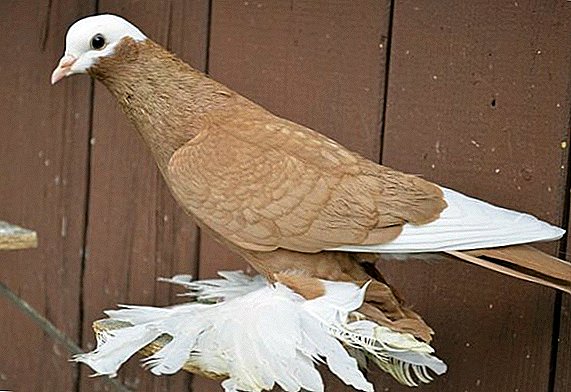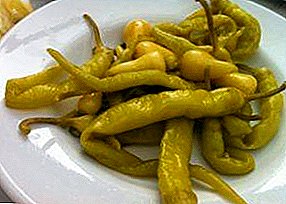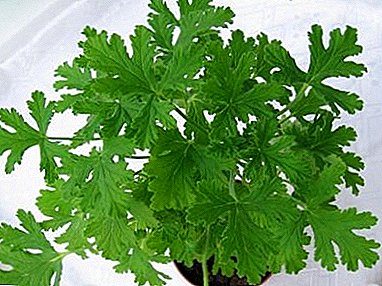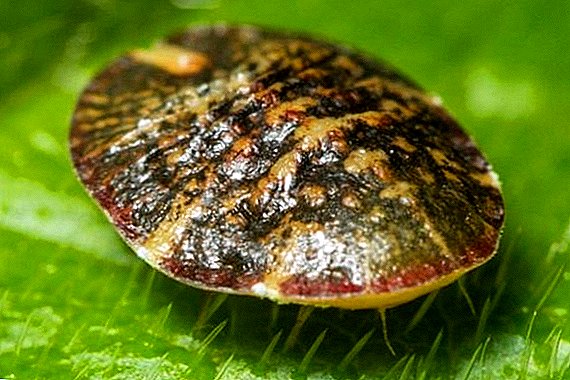 Shatter-guard (other name - "coccides") - is a type of harmful and almost indestructible pests of plants. This insect got its name because of the wax shield that covers the body from above. Consider the description of the pest and methods of controlling it in more detail.
Shatter-guard (other name - "coccides") - is a type of harmful and almost indestructible pests of plants. This insect got its name because of the wax shield that covers the body from above. Consider the description of the pest and methods of controlling it in more detail.
How does it look
The pelletizer has an oval shape, a brown body extending to the sides. The length of the false shield is 4-7 mm, and 1.5 mm wide.
Did you know? This type of insect is a vivid example of sexual dimorphism - the females of the false shield have no legs and wings, they are fixed, and the males have developed limbs and even a pair of wings, the size of the males is smaller than the females and they are mobile.

What is dangerous
This type of pest can bring a lot of trouble to plants, in some cases - even death. Having settled on the plant, the fraudsters drink its juices, the damaged areas turn yellow, turn brown, start to develop incorrectly, the plant begins to dry out, and the young shoots die.
Moreover, the false guard breeds year-round, regularly reproducing offspring, it increases the area of plant damage. This pest multiplies very quickly and a lot. On average, one female of the false guard lays about 2,000 eggs at a time. 
Important! Parasitic on the plant, the false guards emit a sticky substance - honeydew, in which the fungus often breeds. This leads to even greater oppression and deterioration of the plant.
Types and what amazes
Let's look at the most common types of shields:
- Soft This type of pseudoschitovok especially likes to eat indoor plants - orchids, citrus and palm plants. The fecundity of this species is up to 600 eggs. Prefer attached to young shoots or to the veins on the upper side of the foliage. To find it on the leaves can be on a sticky trace on the sheet or candied secretions.
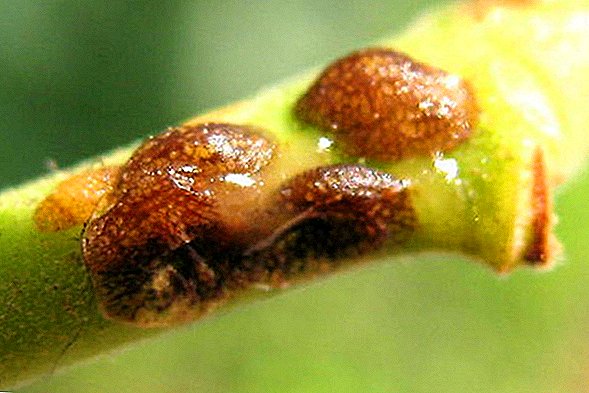
- Acacia spatula. You can meet this parasite in the garden - your favorite trees are peach, plum, acacia, cherry, apple, as well as currant and gooseberry bushes. The fecundity of this type of sham is 1000-2000 eggs.
The larvae hatch at the end of June, they attach to the back of the foliage or to the fruit. In the fall, they migrate to the bark and trunk of trees, where they successfully winter, and in the spring they begin a new breeding cycle.
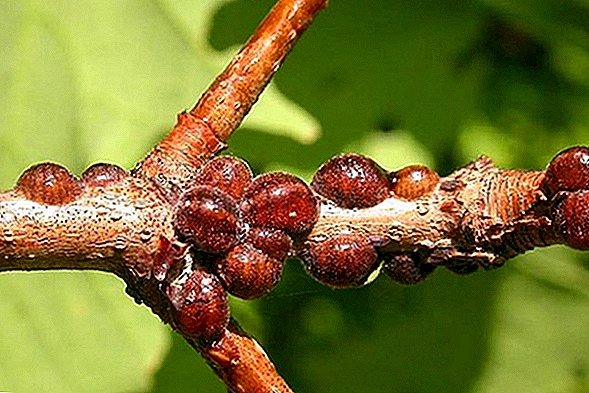
- Spruce false shield. Favorite habitats - coniferous forests, striking branches and needles directly. The fecundity of females of this species is up to 3000 eggs. Hiding under the needles, they are very difficult to destroy. The greatest harm is brought by saplings and young conifers that have not reached the age of ten.

- Hawthorn false shield. This species can be found on apple, medlar, quince, hazel, apricot, turn and cherry plum. Fecundity of females makes up to 1100 eggs. The larvae begin to parasitize on plants during the flowering of apple trees. Hawthorn undershield abundantly secretes a sticky secret in which the fungus develops, which leads to blackening of the leaves and their further deformation. You can find them on the branches and the underside of the leaves.

External signs of damage
If your favorite plant suddenly became wither, yellow or brown spots appeared on the leaves, and sticky discharges appeared on the surface, then the false shield probably settled here.
A detailed examination of the plant's surface can reveal dark brown specks that are very difficult to separate from the leaf or stem.
Important! Processing emulsions of mineral oils (preparation No. 30) reduces the frost resistance of trees. In the case of severe winters, this treatment is done in the spring.
Prevention and agrotechnical rules
One of the main preventive measures against the occurrence of a false shield is a regular and thorough examination of the plants. The timely detection of pests will help stop the damage to plants in the neighborhood.
Trees should not be crowded next to each other, timely watering and spraying of plants is required. For plants in the room and greenhouses need regular ventilation.  Treating trees with fertilizers and supplements that increase pest resistance is also a good preventive measure against these insects. Damaged branches, dried leaves and dead bark should be immediately removed, it will also help reduce the number of parasites.
Treating trees with fertilizers and supplements that increase pest resistance is also a good preventive measure against these insects. Damaged branches, dried leaves and dead bark should be immediately removed, it will also help reduce the number of parasites.
Methods of struggle
It is difficult to destroy a false shield, but it is possible. Let's look at what methods of dealing with these insects exist:
1. Mechanical. This method consists in mechanically clearing the plant's false shield from the plant. To remove pests, use a soft toothbrush or cotton swab. They scrape the insect shields from the damaged surface.
With the defeat of houseplants with a false shield, this countermeasure is especially effective and effective. You can also cultivate the land around the plants with the drug "Aktara".
This drug will penetrate inside and for some time will make the plant toxic to pests. Protective properties after application remain about two months. 
Did you know? Equally effective is the use of biological methods to combat spike shield. This method consists in breeding "beneficial insects", for example - a ladybug and a ground beetle. They feed on eggs and larvae of pests, which helps to significantly reduce their population.2. Chemical. For the treatment of trees and shrubs using insecticides contact action. For example, drug number 30, DNOC, Trichlorol. They are sprayed or washed affected areas. In case of severe damage by pests, they are sprayed with the following drugs:
- Aktara (active ingredient, thiamethoxam). It is bred in such proportions - 0.4 g per 1 liter of water. They can also work the soil. Odorless.
- Actellic (active substance-pyrimiphos-peril). For spraying diluted in such proportions - 1 ml per 1 liter of water. It is strictly not recommended to use in closed rooms, as well as with poor ventilation. This preparation has a pungent smell and disappears for a long time.
- Bankol (active substance-bensultap). Dosage for spraying - 0.7 ml per 1 liter of water. The drug has a faint odor.
 3. People. Popular methods of dealing with these pests help when their numbers are low and the area of damage is small. Most often, ingredients for processing plants are always at hand. You can prepare alcohol or soap solution against sham-proofing.
3. People. Popular methods of dealing with these pests help when their numbers are low and the area of damage is small. Most often, ingredients for processing plants are always at hand. You can prepare alcohol or soap solution against sham-proofing.His recipe is simple - 15 g of liquid soap and 10 ml of denatured alcohol are added to 1 l of water. However, care should be taken to apply an alcohol solution on plants with thin leaves - alcohol can leave a burn.
The effect of this solution is better to check on 1 sheet before processing the whole plant. You can also try to treat the affected areas with various tinctures:
- Garlic - in 1 cup of water add 5 medium cloves of garlic in a crushed form. Before use, the tincture should be infused in a dark place for several hours. If there is no garlic at hand, then 1 medium onion can be used instead. The recipe is the same.
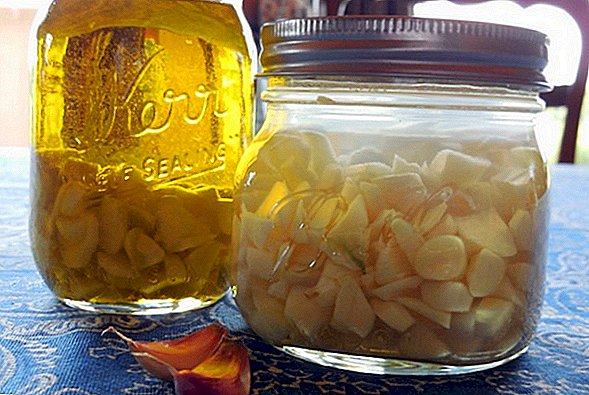
- Pepper - 50 grams of hot pepper is added to 0.5 l of water. This mixture should be boiled, filtered and let stand for a day. And if 10 g of tincture and 5 g of laundry soap are added to 1 liter of water, then you will get another version of the popular way of fighting false shading.
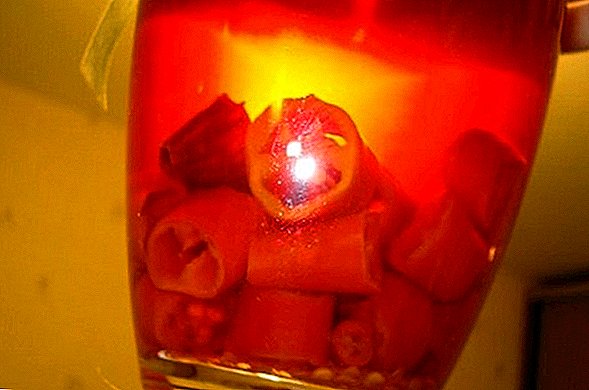
The main difficulty in the fight against pseudo-shield is its microscopic size, look closely at the insect's photo. Now, having discovered all the above signs of its presence on plants, you will know how to deal with it.









